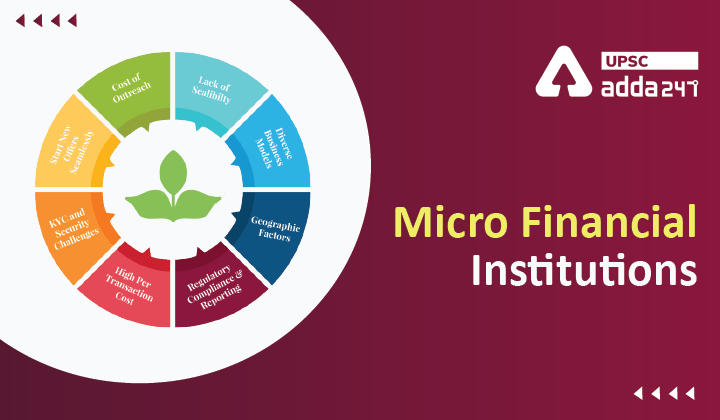Table of Contents
Microfinance Institutions UPSC
Before going into microfinance institutions, let us first understand what is microfinance?
- Microfinance meaning: Microfinance is a form of financial service which provides small loans and other financial services to poor and low-income households.
- Read about RBI Releases Regulatory Framework for Microfinance Loans Directions, 2022
सूक्ष्म वित्त संस्थान (माइक्रो फाइनेंस इंस्टीट्यूशंस/एमएफआई)
Microfinance objectives
- Microfinance is an economic tool designed to promote financial inclusion which enables the poor and low-income households to come out of poverty, increase their income levels and improve overall living standards.
- Microfinance can also facilitate achievement of national policies that target poverty reduction, women empowerment, assistance to vulnerable groups, and improvement in the standards of living.
Microfinance institutions in India
- MFI is a financial organisation that offers financial services to low-income populations.
- These services include microloans, microsavings and microinsurance.
- In 2010, on recommendations of H. Malegam Committee (by RBI), RBI created a new NBFC category called Micro Finance Institution (MFI).
- MFI gives small loans to the poor without collateral, flexible EMI.
- In India, all loans that are below Rs.1 lakh can be considered as small loans or microloans.
- MFIs are regulated by The Non-Banking Financial Company -Micro Finance Institutions (Reserve Bank) Directions, 2011 of the RBI, and the Ministry of Corporate Affairs.
- Households whose annual income is not more than ₹ 1.25 lakh (rural) or ₹ 2 lakhs (urban) are eligible to borrow from MFIs. However, maximum borrowing should not be more than ₹ 1.25 lakh.
- Indian microfinance sector has witnessed phenomenal growth over past two decades in terms of increase in both the number of institutions providing microfinance as also the quantum of credit made available to the microfinance customers.
Microfinance institutions issues
- Inadequate data: The overall loan account have indeed been increasing, however, their impact on the economic status of the people is not well documented.
- Over-indebtedness: The growing trend of multiple borrowing by clients and inefficient risk management are some of the most significant factors that stress the microfinance industry in India.
- Higher interest rate: Most Microfinance Institutions charge a very high rate of interest (12-30%) when compared to commercial banks (8-12%), due to which the financial success of MFIs is limited when compared to commercial banks in India.
- Dependence on banks: Most of the microfinance institutions are registered as Non-Governmental Organizations (NGOs), and depend on the formal banks like the commercial banks for stabilized funding. This dependence of Indian MFIs on banks makes them incompetent as a lending partner.
- Loans for non-income generating purpose: The proportion of loans utilized for non-income generating purposes could be much higher than what is mandated by the RBI, which is 30% of the total MFI loans.
- Geographic Factors – Around 60% of MFIs agree that the geographic factors make it difficult to communicate with clients of far-flung areas, which create a problem in growth and expansion of the organization.
Microfinance institutions solutions
- MFIs should focus on creating a sustainable and scalable microfinance model with a mandate that is unequivocal about both economic and social good.
- MFIs should also ensure that the ‘stated purpose of the loan’, that is often asked from customers at the loan-application stage, is verified at the end of the tenure of the loan.
- RBI should also encourage all institutions to monitor their impact on society by means of a ‘social impact scorecard’.





 TSPSC Group 1 Question Paper 2024, Downl...
TSPSC Group 1 Question Paper 2024, Downl...
 TSPSC Group 1 Answer key 2024 Out, Downl...
TSPSC Group 1 Answer key 2024 Out, Downl...
 UPSC Prelims 2024 Question Paper, Downlo...
UPSC Prelims 2024 Question Paper, Downlo...
